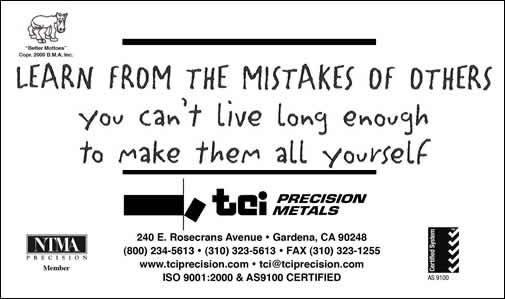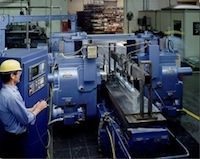TCI News - Workers' Comp
Motto of the Month


President's Corner
The Workers' Comp Classification Scam
Over the past few months, it's been very busy (too busy, it sometimes seems, to have written a monthly blog). But I'm back at it, and intend to stay on track here at the keyboard. And to begin 2012, I need to let off a little steam and present an issue that is more than a cautionary tale.
I don't know how workers' compensation laws work where you live, but here in California it seems that the more I learn, the less I want to know. We've all heard about the anti-business nature of our legislature in Sacramento. It's legendary and I've written about it in the past.
This next slight comes in the form of regulations set forth that govern the workers' compensation classifications of employees. As is likely a nationwide standard, the rate we all pay for workers' compensation insurance is based on payroll, head count and job classification. At the beginning of the "insurance year" we estimate head count and payroll and clearly identify which people are performing which job functions. After the close of the "insurance year", the carrier performs an audit to attest that we've estimated correctly and honestly to understand whether we've paid an appropriate premium given our risk. So far, so good?
Now, it turns out that we have several job classifications, as most shops do: "clerical office employees, salespersons, machine shops and stores-wholesale". You would think that, with all of the opportunities for injury on a manufacturing floor that the "machine shops" classification would be the highest rate per $100 in payroll. You would be wrong. It's the "stores-wholesale" classification (in our case, picking, packing and shipping) that is the most expensive.
But that's not the worst part, or even the point of this piece. It's just the set-up (so to speak). For the first time in history, the carrier's auditor asked some our clerical and sales-classed individuals whether they spent any time on the shop floor; and if yes, why and where. The answers were consistent with good business practice. First, they were honest. Second, they explained that in the normal course of business, it's important to understand the basics, if not the complexities of how parts are made.
According to the Workers' Compensation Insurance Rating Bureau of California (WCIRB) it turns out that an office worker or salesperson can't spend more than ZERO minutes per day on the floor without being re-classed into the most expensive rate in the business on the theory that the risk for injury during those few minutes justifies the higher premium.
Oh. And the rate per $100 of payroll is almost 15 times higher than the rate for the position in which the person is legitimately classed.
It's no wonder that California has developed a reputation for being business-unfriendly. And it's just another cause-and-effect of a clueless legislature in Sacto and a perennially broken and mis-managed California workers' compensation insurance system.
And how does small business answer that question during the next audit cycle? And what will you do when that auditor comes to visit?
When I began my monthly comments in this space, I assured you that it wouldn't be your garden-variety blog, at least most of the time. I hope you agree that I've kept my promise.
Until next month...
-John Belzer

This Month's Featured Process - Duplex Milling
|
Duplex Milling is the most cost effective way to produce high quality square-corner blanks. Duplex Milling provides blanks with squareness and parallelism tolerance to .0002" and reduces pre-machining costs up to 50%. To achieve such a close tolerance, blanks ready for Duplex Milling are clamped in place with two sides exposed for milling. Then, opposing cutters run the length of the material removing equal amounts of material from each side. Pre-machining costs are reduced by milling two sides of the blank simultaneously. This combination of accuracy and speed provides a blank with superior tolerances, squareness, parallelism, and surface finish (up to 16 Ra) at significantly lower costs. |
 |
